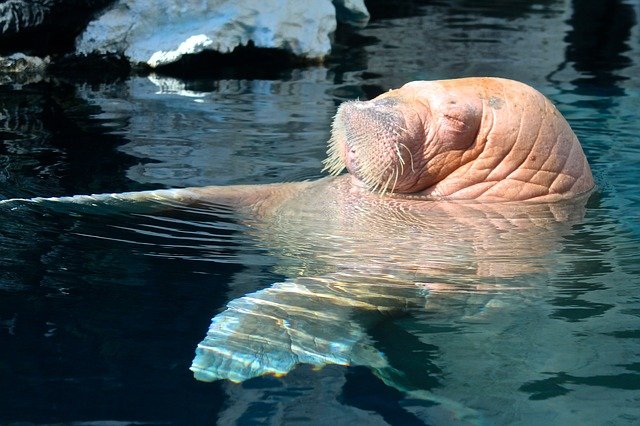SeaWorld Orlando Veterinarian Dr. Stacy DiRocco Discusses Walrus Conservation
Image by nightowl from Pixabay
Dr. Stacy DiRocco, a senior veterinarian at SeaWorld Orlando, has committed her professional life to leading an all-female team of veterinarians. Throughout her career, Dr. DiRocco has spearheaded various medical practices and operations that have impacted the field, in addition to providing care for many species of animals at SeaWorld Orlando.
Recognizing the importance of research and conservation work, Dr. DiRocco values SeaWorld’s commitment to collaborating with various organizations to provide research, analysis, comparison samples, and data collection. Of SeaWorld’s commitment to research and animal care expertise, Dr. DiRocco stated, “SeaWorld is now in a position where other facilities are reaching out to us for guidance to carry out procedures that have never been done before.”
Recently, Dr. DiRocci reached an important distinction in her care of adult walruses and newborn pups. Of the 14 walruses currently under veterinary care in the United States, Dr. DiRocco works with three of them.
Dr. DiRocco’s Experience With Walrus Care And Reproduction
At 16 months, a walrus pregnancy is nearly twice as long as a nine-month human pregnancy. For Dr. DiRocco and her team, this lengthy gestation period provided ample opportunity for research, examination, and observation. As walruses Ginger and Kora were the first pups born under the care of a veterinarian, Dr. DiRocco and her team prepared for an unprecedented experience, one that could benefit the scientific community in the future.
Without an ability to confirm the walrus’s conception date, Dr. DiRocco and her team needed to monitor the pregnant walrus 24 hours per day, seven days a week, in order to predict when she would go into labor with her second pup. As the walrus got closer to the perceived birthing window, Dr. DiRocco worked tirelessly to ensure a successful delivery.
The experience of assisting in the birth of two walrus pups remains a highlight in Dr. DiRocco’s career. Dr. DiRicco touted, “Everyone in the park veterinary and animal care team was involved. That was the second walrus birth ever at the Orlando park, so we all were waiting with bated breath for this incredibly special moment.”
Dr. DiRocco’s Love for Rescue Care Animals
As a long-time staff veterinarian at SeaWorld Orlando, Dr. DiRocco loves the excitement of the job. “No two days are alike. We spend a lot of time on routine physical exams across the park. But what really makes the days exciting are the rescue animals in our care,” says Dr. DiRocco.
She goes on to explain that although many animals that arrive for rescue care at SeaWorld Orlando have similar injuries or illnesses, each one is unique. Dr. DiRocco reports that she learns a lot from every new animal she treats and that her goal is to fight for the lives of the animals as resolutely as they do. One of the most rewarding parts of her job is returning animals back into the wild after they go through rehabilitation to restore their health.
Zoos and Aquariums Nationwide Look to SeaWorld for Veterinary Inspiration
Marine animals in the care of organizations like SeaWorld are typically easier for veterinarians to study and treat. They have greater challenges attempting to do the same for animals in the wild. As a result, veterinary professionals look to SeaWorld as a collaborative leader, allowing veterinary staff and researchers to learn best practice techniques when providing treatment for animals in the wild. Veterinarians from other facilities frequently ask SeaWorld animal care staff to collaborate with them when performing a procedure for the first time.
Is the Walrus a Vulnerable Species?
The International Union for Conservation of Nature lists walruses as a vulnerable animal population. However, they don’t receive nearly the attention other species do since their vulnerability is difficult to quantify. This is because no one has an accurate count of how many walruses exist in the world today. Additionally, some wildlife and environmental groups have determined that walruses can adapt to climate change and other environmental challenges with relative ease.
One reason walruses were vulnerable in the past is that people hunted them for their ivory tusks to make into jewelry and other high-end consumer products. Although laws are now in place that forbid this practice, the walrus population continues to face threats from the effects of people exploring oil in the Arctic and melting ice. SeaWorld has collaborated with many partners to help lead the way in helping preserve the walrus population.
A Glimpse at What SeaWorld Does for Walruses
SeaWorld San Diego hosts much of the walrus research, as five of the 14 walruses at aquariums and zoos live at the California location. Veterinarians at all SeaWorld locations work in partnership with local universities to create humane research programs to help them better understand the needs of the walrus. The research studies investigate physical and behavioral issues and how the environment walruses inhabit can impact both. Universities benefit from the partnership as well, since it prevents staff from having to conduct a research expedition in the Arctic for the sake of data collection, observation, and research.
The walruses, and all animals at SeaWorld, receive the best possible care from a team that includes animal care specialists, veterinarians, and assistants. Each SeaWorld research facility has the primary goal of supporting the health and conservation of walruses and each species of animal living on park grounds. The walruses that reside at SeaWorld locations help staff educate the public about the species and what people can do to support their survival.

